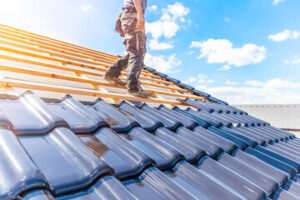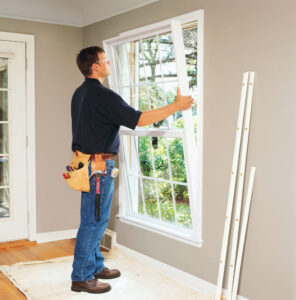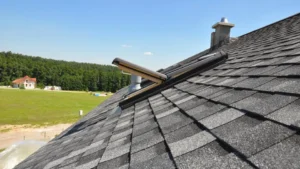A roof is the covering over a building that protects it from rain, snow, sunlight, and extreme temperatures. It can be flat or sloped and come in many different forms.

The choice of roofing material affects the cost, maintenance requirements and climate suitability of a building. Some methods also have a payback period to recover their initial investment. Consult Roofing Wilmington DE for professional help.
The type of roofing material you select can make a significant impact on the lifespan and overall performance of your roof. Each option offers distinct advantages and disadvantages that should be carefully weighed before making a final decision. For example, slate tiles are popular in warmer climates, and they are fire-resistant and energy-efficient, but they are also more expensive than other roofing materials.
A wide range of materials are used in roofing, from natural products like thatched straw or sticks to modern asphalt shingles and high-density spray polyurethane foam (SPF). Choosing the right material for your home will depend on many factors, including cost, longevity, and esthetics. A roofing specialist can help you determine the best materials for your specific project.
Metal roofing is a popular option for sloped structures, such as sheds and garages. It is long-lasting and low-cost, and it can withstand most weather conditions. There are several types of metal roofing, including galvanised and stone-coated steel, and each has different properties.
Other popular roofing materials include clay or concrete tiles, which are durable and fire-resistant, and slate, which is a natural stone product that lasts up to 100 years. Tiles are available in a range of colors and styles to complement your home, and they can be customized to fit most roofing pitches.
Another common roof covering is rolled roofing, which consists of large rolls of mineral-impregnated and asphalt-impregnated material topped with mineral granules. It is inexpensive, easy to install, and can be used on sloped residential and commercial buildings.
Wood shingles and shakes are traditional roofing materials that add an attractive aesthetic to your home. They are durable and suitable for most moderate climates, but they can be prone to moss and mildew. They are also a little heavier than other roofing materials, which can affect the structural integrity of your home.
Another alternative is corrugated galvanised iron, which is a long-lasting, cost-effective roofing material that can withstand strong winds and rain. It is manufactured with wavy corrugations that resist lateral flexing and is fitted with exposed fasteners. This roofing material is not as attractive as other options, but it is a good choice for budget-conscious homeowners.
Installation
Your roof protects you from rain, snow, wind, extreme heat, and sunlight. The materials that make up your roof and how they are installed affect its performance, durability, and appearance.
When reroofing your home, it is important to use a professional with experience in the type of roofing you are having installed. Some manufacturers have programs to credential contractors who have undergone training on how to install their products. Your homeowners insurance may also have a list of approved contractors.
The first step in installing a new roof is to prepare the surface. A roofing contractor will remove the existing shingles and underlayment, then apply new underlayment and felt paper. The contractor will nail both the underlayment and shingles, with nails closer together at the edges of the roof and further apart as they get towards the middle. The contractor will then add ice and water protection, which is a thin layer of material that defends against both ice dams and wind-driven rain that can force water up under shingles. Your contractor may also install flashing, which is metal that seals the joints where different roofing planes meet.
Maintenance
Roofing is subject to frequent assaults from wind, rain, snow, extreme cold, intense sunlight and other weather conditions. A well-designed roof can stand up to these insults, but it does need routine maintenance to perform at its best.
A maintenance program should include a number of procedures designed to extend the life of the roofing system and reduce repair costs. The program can be managed by facility staff, although specialized or extensive repairs or roofs covered by an active warranty are normally contracted to roofing professionals.
Housekeeping surveys should be conducted on most roof areas monthly to keep drainage devices open and identify conditions that require corrective action. These surveys should be scheduled with enough lead time to allow the completion of any temporary corrective work that may be necessary before a storm or heavy rainfall.
Drains, scuppers and gutters should be kept free of debris to ensure effective drainage and prevent ponding water or the formation of algae, moss and fungus. The accumulation of these materials can restrict the flow of water, accelerate membrane deterioration and pose a puncture risk from sharp edges or wind driven movement. Regular trimming of trees that overhang flat roofs is recommended to avoid tearing or puncturing the membrane.
Sealants and caulking around penetrations and wall flashing should be examined for cracking, openings and deterioration. Leaks at these points can be extremely expensive to correct. Chimneys should be inspected for the build up of a soot-like material called creosote and cleaned as needed. A visual inspection should also be made of the vent outlets and skylights. All of these items should be cleaned and a fresh coat of caulk applied when needed.
Repairs
Whether your roof needs repair or replacement, you need to make sure that the job is done properly. If you hire a professional, they’ll inspect the roof and determine what repairs are needed. They’ll also make sure that the underlying materials are protected from water and weather damage. In addition, a good roof will help prevent drafts and keep the house cool in summer and warm in winter.
The cost of roofing repair depends on a number of factors, including labor and the type of repairs required. If a large area of the roof requires replacement, it can be more expensive per square foot than repairing isolated damage. This is because a contractor won’t be able to take advantage of bulk discounts for materials.
In general, the cost of roofing repair is less than the cost of a full replacement. However, you should be aware that re-roofing can void the warranty on new shingles and will also require more labor than repairing an existing roof.
Some roofing repairs may be covered by your home insurance, particularly if the damage is due to fire or storm damage. But most everyday wear and tear is not.
When it comes to roofing repair, there are several tools that you’ll need. Those include a pry bar, which is used for removing shingles and leveraging sheathing or other materials, as well as a set of shears, which are helpful for neatly cutting shingle courses. You’ll also need a set of roofers’ gloves, which are thicker than ordinary work gloves and are designed to protect your hands from the sharp edges on shingles and other roofing material.
Another necessary tool is the hammer, which is used to break through old shingles and nails in the sheathing or decking. You’ll also need a set or two of roofing nails, which are longer than standard nails and can penetrate deeper into the sheathing to hold the shingles in place. Finally, you’ll need some kind of sealant, like roof cement or caulking, to seal leaks and cracks in the shingles and sheathing.







